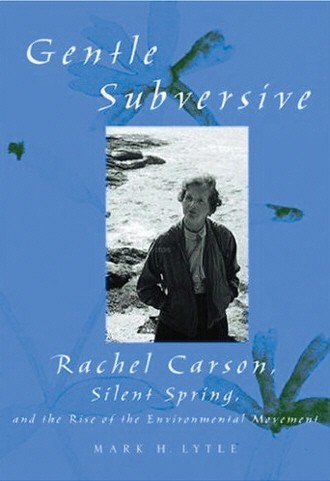|
The Gentle Subversive: Rachel Carson, Silent Spring, and the Rise of the Environmental Movement By Mark Hamilton Lytle Oxford University Press $23, 176 pages |
Silent Spring, whose original working title was Man Against the Earth, is a carefully documented account of how human beings are poisoning the planet with toxic chemicals as well as an eloquent plea to restore the delicate balance of nature. When the book first appeared, to celebration and vituperation, its author, Rachel Carson, had already established a reputation as an outstanding science writer. Sales of her first book, Under the Sea-Wind: A Naturalist’s Picture of Ocean Life (1941), were hurt by an incident at Pearl Harbor a few weeks after its publication, in November 1941. But the commercial success of both The Sea Around Us (1951) and The Edge of the Sea (1955) enabled Carson to leave her job at the United States Fish and Wildlife Service and devote herself to writing.
Mark Hamilton Lytle, a historian who teaches at Bard College, attributes Carson’s achievement to her talents as both scientist and writer: “Her dedication as a scientist made her credible; her gifts as a writer made her inspirational.” He characterizes her as “a gentle subversive,” who, despite and because of her lack of flash, managed to trigger a paradigm shift.
The Gentle Subversive is a succinct volume that, in chapters titled with the seasons of the year, traces Carson’s life, from her birth near Pittsburgh in 1907 to her death in Maryland in 1964. She pursued graduate work in zoology at Johns Hopkins University but was frustrated by obstacles to women in science. Forced to support her mother, sister, and nephew during the Depression, Carson took a government job that did not allow her to exercise fully her research interests and abilities. She lived with her mother until the older woman’s death, and she adopted her nephew after her sister died. She never married, and her most intimate relationship was with a woman named Dorothy Freeman who lived near Carson’s summer house on the coast of Maine.
Lytle acknowledges his debt to earlier biographies by Paul Brooks and Linda Lear. The Gentle Subversive does not attempt to recreate the dense textures of an individual life so much as use the outline of that life for reflections on social and political change. Nor, beyond vague praise for Carson’s lyrical prose, does Lytle offer much analysis of what makes it work. The Carson whom he admires — “environmentalist, career woman, scientist, animal-rights activist, faithful daughter and beloved aunt, female role model, devoted friend, gifted writer, and political dissenter” — was a catalyst for new attitudes toward nature, science, consumption, and government.
Warning that pesticides were polluting rivers and lakes and, by obliterating wildlife, including songbirds, creating a silent spring, Carson’s most famous book challenged conventional faith in what the DuPont Corporation called “better living through chemistry.” Science is not always benign, especially if practiced out of an urge to vanquish nature.
Lytle suggests a parallel between the project to exterminate fire ants during the 1950s and Joseph McCarthy’s campaign to eradicate Communist infiltrators. Anyone who opposed either risked being branded un-American. When Carson documented the damage caused by DDT, leaders in the chemical industry, agribusiness, medicine, and government mounted an organized effort to discredit her. Robert White-Stevens, an official at American Cyanamid, called her “a fanatic defender of the cult of the balance of nature.”
The cult became a consensus. Though weakened by radiation treatments and the cancer that would soon end her life, Carson fought back against her detractors and conquered public opinion. Her benefaction can be seen in Earth Day and the Environmental Protection Agency and, more generally, in dragging us out of what she, libeling Neanderthals, called “the Neanderthal age of biology and philosophy, when it was supposed that nature exists for the convenience of man.”
Carson, a peer of Henry David Thoreau, John Muir, Aldo Leopold, and David Brower, was not the first to demand respect for the entire web of life. But it took a demure woman equally adept with microscope and typewriter to awaken a nation to natural truths.
As Lytle notes in his epilogue, revisionists, for whom “environmentalist” is a noxious epithet, have been chipping away at Carson’s legacy. And the same blend of ignorance, greed, and sloth behind the attacks on Silent Spring have reemerged in the campaign to discredit Gore’s An Inconvenient Truth. Those who insist on immediate action to confront the crisis of climate change risk being labeled enemies of prosperity and free enterprise, as though carbon emissions were a measure of patriotism. Rachel Carson, we still need you to clear the air.


